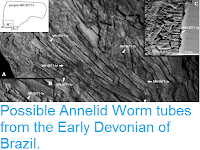The Machaeridians are a group of armoured, worm-like invertebrates known from Ordovician-Permian deposits. They had a worm-like body covered in large calcified sclerites (plates), and are usually found in disarticulated form. For a long time, palaeontologists speculated about what group the Machaeridians belonged to, with suggestions that they might be Molluscs, Arthropods Echinoderms or Annelids. Recent discoveries of well-articulated specimens have placed the group firmly within the Annelids, though it is unclear whether they are crown-groups Annelids (i.e. descended from the common-ancestor of all living Annelids) or whether they are a stem group (i.e. more closely related to Annelids than any other group, but outside the crown group).
In a paper published in the journal Acta Palaeontolonica Polonica on 24 May 2017, Benjamin Gügel and Kenneth De Baets of the Geozentrum Nordbayern at Friedrich-Alexander Universität Erlangen-Nürnberg, Iwan Jerjen of the Department of Information Technology and Electrical Engineering at ETH Zürich, Philipp Schuetz of Technik & Architektur at Hochschule Luzern and Christian Klug of the Paläontologisches Institut und Museum at Universität Zürich, describe a new species of Machaeridian from the Middle Devonian Nandan Formation of Guangxi Province in China.
The new species is placed in the genus Lepidocoleus, which has previously described from Ordovician to Devonian deposits in northern America, Europe, southeast Asia, and northern Africa, and given the specific name kuangguoduni, in honour of Kuang Guodun, who served as a field guide for the expedition which found the specimen, for his contributions to research on Paleozoic invertebrates. The species is described from a single disarticulated specimen, preserved as an iron-oxide replacement fossil within a claystone matrix.
Machaeridian Annelid, Lepidocoleus kuangguoduni, Nandan Formation, Eifelian, near Napiao, Guangxi (China). (A) The main plate containing most machaeridian sclerites. (B) The counterplate of the same specimen; note the limonitic filling of the rugae and the chaotic arrangement of the plates. Gügel et al. (2017).
The specimen was CT-scanned at the Swiss Federal Laboratories for Materials Science & Technology, in order to create a three-dimensional model, revealing structures hidden within the matrix. This showed the presence of sixteen sclerites and partial sclerites. Seven of these sclerites are more-or-less complete, and show dorsal flanges typical of a Lepidocoleid Machaeridian.
Overview over the assemblage of the sixteen 3D-objects which were created from different viewpoints. Orthographic top (A) and front (B) views. Orthographic top view (C), projected on the sample to show the position of the 3D-model in the correct position on the x-y-plane and corresponding viewing directions. Orthographic left side (D) and right side (E) views. Gügel et al. (2017).
Two of the sclerites (labelled 1 and 2 above) were closely associated and appeared to be semi-articulated, making them good candidates for further investigation of the movement of the plates. These were then re-created using a 3D printer, producing a pair of overlapping sclerites articulated by a sinuous, subtriangular depression on the dorsal surface.
View of a pair of 3D-prints of articulated right 1 and left 2 sclerites from obliquely posterior (A) and dorsal (B) views. Note the perfect fit of the sclerites. Within the hinge of sclerite 1 in (B), the indentation on the right of the hinge flange is an artefact from tresholding (probably, the shell was too thin in that place). Sclerites 1 and 2 were enlarged 25 times. Gügel et al. (2017).









